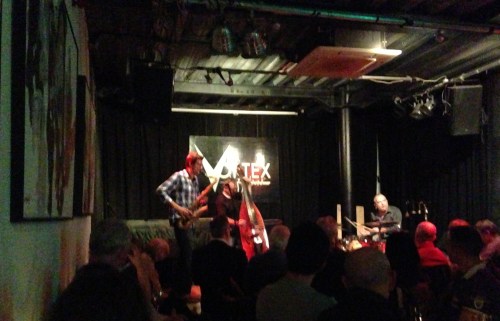Mingus fingers
 About 20 minutes into Whahay’s set at the Vortex last night, Paul Rogers dug out a small steel cylinder and slipped it over the little finger of his left hand. A few seconds later he was playing bottleneck double bass: a fantastic sound.
About 20 minutes into Whahay’s set at the Vortex last night, Paul Rogers dug out a small steel cylinder and slipped it over the little finger of his left hand. A few seconds later he was playing bottleneck double bass: a fantastic sound.
It helped that he was playing his seven-string instrument, a beautiful thing with sloping shoulders, custom-built for him by a luthier in Nîmes. The fifth string is where the extra string on a five-string bass can usually be found, tuned to B, a fourth below the lowest string on a conventional instrument. The sixth and seventh are at the upper end of the register, tuned to C and F. It also has 14 sympathetic strings, set longitudinally under the bridge and the tailpiece.
The result bears some resemblance to a medieval viola da gamba, or the Italian viola bastarda of the 16th and 17th centuries. And in Rogers’ hands it can sound not just like a contrabass but like a cello, a lute, an oud, a finger-picked acoustic guitar, and sometimes — when he grips the strings with the fingers of both hands before wrenching them violently away in opposite directions — like an explosion in a factory making industrial-strength rubber bands.
Rogers moved to London from his native Chester in the mid-’70s and was regular on the British improvising scene, notably in various groups with Keith Tippett, John Stevens, Elton Dean and others, for more than a decade before moving first to the US and then to France, where he has lived since 1992 (currently in Le Mans). He had the seven-string bass made because he wanted something lighter and more travel-friendly than his usual instrument, but it has given him an enlarged vocabulary that is brilliantly displayed in the context of his current group.
Whahay is a trio in which Rogers is joined by the tenor saxophonist and clarinetist Robin Fincker, who was born in France but has lived for several years in London, where he is a member of the Loop Collective, and the drummer Fabien Duscombs, who first met Fincker when they were both studying in Toulouse. Their newly released debut album applies the techniques of free improvisation to the music of Charles Mingus, a project they’ve been working on for a couple of years.
Here’s a way of describing their sound and approach. If you drew a line from Mingus’s Blues & Roots to Albert Ayler’s Spiritual Unity, and called the distance x, and then continued the line until it reached Whahay, the distance between the first and third points would be something like 2.5x. That’s an attempt to explain the method by which Mingus’s tunes — including “Better Git It In Your Soul”, “Bird Calls”, “Ecclusiastics” and “Pithencanthropus Erectus” — are subjected not just to extreme abstraction but to the extended instrumental techniques that have evolved since Ayler’s heyday in the mid-’60s.
The album is terrific, but the gig was an absolute monster. After a slightly muted start, in which they sounded unexpectedly pastoral (more like a Jimmy Giuffre trio than an Ayler band), the three musicians hit their stride and didn’t pause for an hour, moving in and out of time, slipping easily from three-way conversations to duos to monologues, picking up cues with near-telepathic perception and showing how far they have advanced their interplay since the album was recorded in the spring.
Duscombs is an unusual player who seems constantly intent on taking his kit by surprise: his sticks appear to recoil from the playing surfaces, pulling the sound out of the startled drums and cymbals rather than hammering it in. Fincker, the least obviously assertive member of the group, is a hugely resourceful improviser who always found something interesting to add. Rogers was consistently astonishing in his combination of physicality and delicacy, whether sawing away with his big German bow or using all his fingers to tap out a filigree of shimmering harmonics.
What would Mingus have thought of it all? He was notoriously sceptical of free music. One summer’s day in 1972, over lunch at a table outside a cafe in Shepherd Market, he gave me a version of his standard line: “Some painters draw seriously, they draw precise lines and certain perspectives that correspond with something you’ve seen before. Then you get guys who throw paint at a canvas, throw some sand on top of it, and they say they paint. Some people let monkeys and little children use their fingers on it, and they call it good painting.” He looked up from his oxtail soup and glared at me. “It’s time for guys like you to decide what you want: bullshit, or something real.”
What Paul Rogers, Robin Fincker and Fabien Duscombs did last night was real enough. I think Mingus would have loved it.
* Whahay is distributed in the UK by the Babel label.
